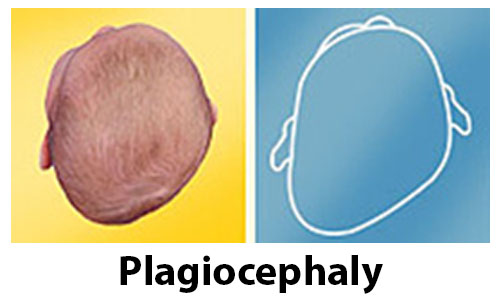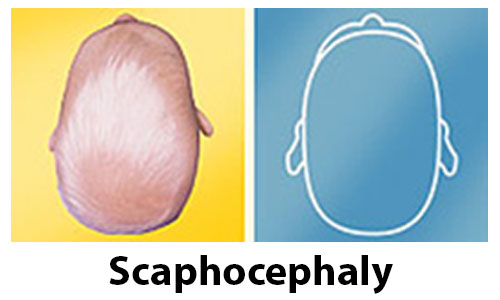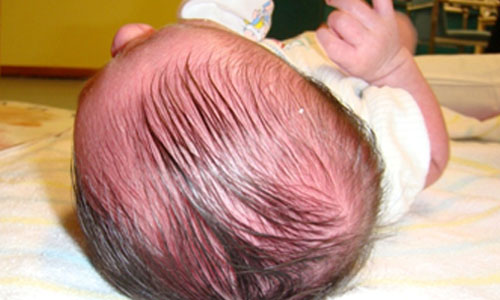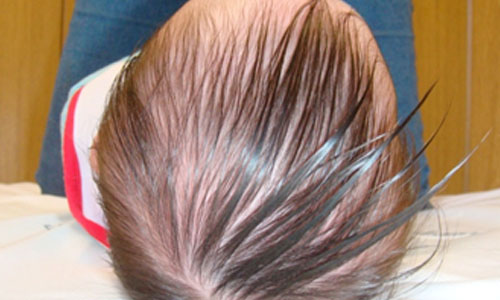
PLAGIOCEPHALY
Does your baby have a mis-shapened head? He could have Plagiocephaly.
Plagiocephaly (Misshapen heads)
Misshapen heads can be the result of many causes such as:
1. Craniosynostosis. This is the early closure of the cranial sutures. These conditions usually require surgical intervention in the first year of life.
2. Craniofacial Syndromes. An example is Apert’s Syndrome, which is a genetic condition.
3. Positioning. This is the most common cause of misshapen heads, and is often associated with Congential Torticollis.
Head Shape Impacts Development



Above are 3 types of typical presentation of misshapen heads. A misshapen head may occur in the first 6 – 8 weeks after birth if the baby has constant pressure on one part of their head. This may occur if the baby sleeps and plays in one position for long periods of time, usually on their back. This tends to result in a Brachycephaly head shape.
When the baby consistently turns their head to one side only when lying on their back, this tends to result in a Plagiocephaly head shape. Plagiocephaly head shapes are often associated to Congenital Torticollis.
Scaphocephaly head shapes tend to be found in premature babies because they were born too early and required nursing side to side in Neonatal Intensive Care or Special Nursery.
A localized "flat spot" at the back and/or side of the head can develop very quickly in a young baby. Once a flattened area has developed, it is easy for the baby to continue to rest on this flat area leading to further flattening and asymmetry.
It has become apparent that many infants with deformational plagiocephaly also have torticollis.
Risk Factors for Plagiocephaly
The noted risk factors for Plagiocephaly are:
- primiparous mother (first time mums),
- large birth weight,
- male gender,
- breech position,
- multiple birth, and
- maternal uterine abnormalities.
Consequences of Deformational Plagiocephaly and Torticollis
Left untreated, Plagiocephaly and Torticollis can result in permanent distortion of the head as well as persistent facial asymmetry.
The persistent side preference as a result impacts on the infant developing normal midline movement, awareness of both sides of their body, bilateral arm use and ultimately delays their gross motor skills development.
Several studies have found that the median age for the deformity to be first noted by parents was 6 weeks (range 4-10 weeks).
Studies have shown that children with deformational plagiocephaly in the high risk group, which includes males with abnormal head shapes at birth associated with uterine constraint, need to be closely followed for potential developmental delay presenting as subtle problems of cerebral dysfunction during the school-age years.
How My Favourite Physio can help
Misshapen heads can be the result of many causes, and different causes require different treatments. It is important to have the correct diagnosis to ensure the right treatment is carried out. At My Favourite Physio, we have expert knowledge and skills to carry out a full assessment of babies’ neck muscles and head shape, in order to correctly diagnose and effectively treat Plagiocephaly. When discovered early, and appropriate stretching exercises and positioning are followed consistently, 80% recover completely with no long-term effects.
Plagiocephaly can be effectively treated with Physiotherapy. Early intervention is the key to a successful outcome. Studies have shown that the best outcomes are achieved when babies are assessed and treated as soon as possible and below the age of 6-7 months old.

baby at 3 weeks old

baby at 6 weeks old
Worried about your baby’s head shape because they keep looking to one side? Is your baby’s head getting flat at the back because he doesn’t tolerate tummy time? Don’t wait another day to correct the problem! Ring today on 02 9790 4233 to book an appointment with our Paediatric Physiotherapist and let us help correct your baby’s head shape and help him to start enjoying tummy time.
